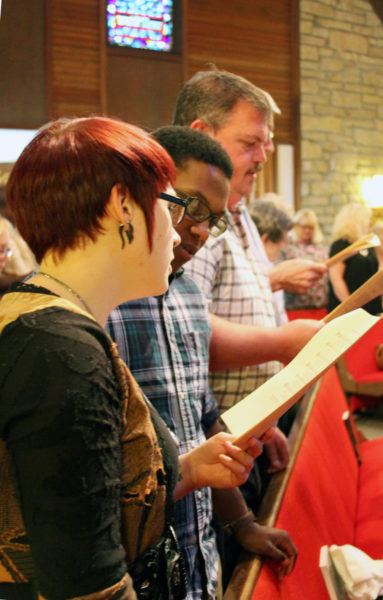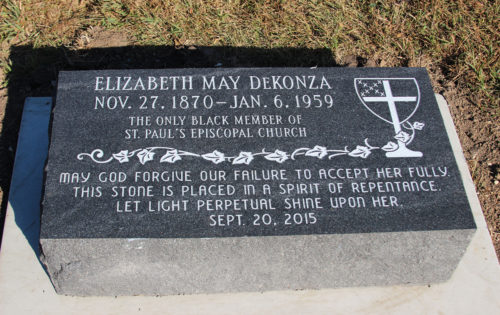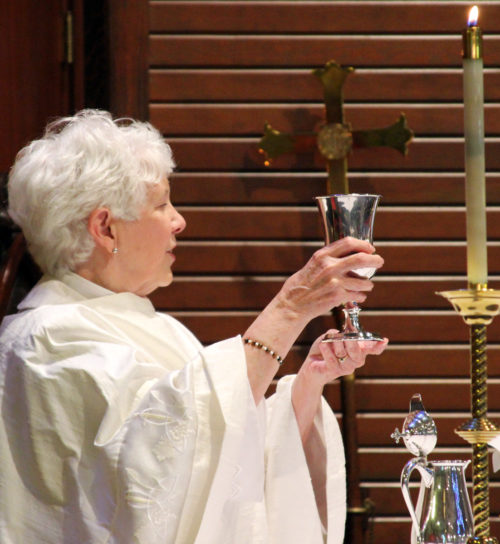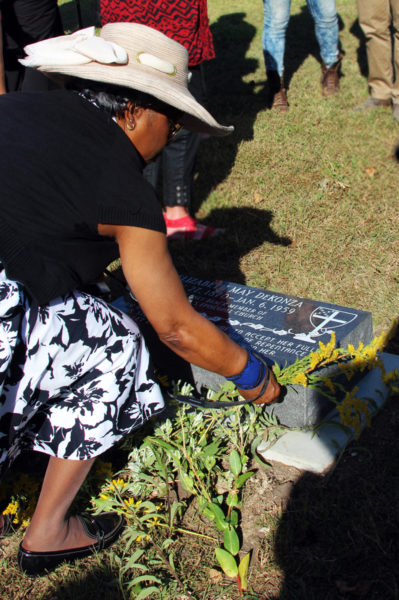Kansas church repents treatment of its only black memberPosted Sep 30, 2015 |
|

Members of St. Paul’s and guests gather at the grave of Mai DeKonza for the blessing and dedication of a stone on her previously unmarked grave, 56 years after her death. Photo: Melodie Woerman/Diocese of Kansas
[Episcopal Diocese of Kansas] On a recent Sunday afternoon, St. Paul’s Episcopal Church in Clay Center, Kansas, was packed with worshippers, including half a dozen guests from the Ward Chapel AME Church in nearby Junction City.
They had gathered Sept. 20 for a service of repentance, healing and reconciliation to acknowledge the mistreatment of the only African-American member in the church’s 134-year history, Mai DeKonza, who died in 1959.
Over and over again, the people prayed, “Forgive us our sins. Forgive us our sins. Forgive us our sins.”
DeKonza, who was confirmed in 1900 in the small church in north-central Kansas, was a poet, musician, playwright and prolific letter writer who mostly was ignored by her fellow church members during her 59-year membership. Her separation from them was even more complete by their use of a designated chalice to administer communion only to her.

Parishioners and guests sing a hymn that was written by Mai DeKonza during the service of repentance. Photo: Melodie Woerman/Diocese of Kansas
Now, to help give her a voice in the church that she didn’t have in life, the service included excerpts from letters she had written to Bishop James Wise, the fourth bishop of Kansas who served from 1916 to 1939, as well as a hymn she wrote that had been arranged by parish organist Sandra Carlson to the tune Finlandia.
And when it came time for communion, the only chalice on the altar was the one that had been reserved for DeKonza.
In her sermon, the Rev. Lavonne Seifert, the church’s priest-in-charge, said that the service was to address twofold sorrow. “Today, we express our sorrow for the actions and inactions of those good Christian people who worshipped in the era of ‘Jim Crow church,’ as Mai described it,” Seifert said. “But I am most sorry that those who came before us missed the opportunity to really know Mai DeKonza and to hear her wisdom, benefit from her insights and enjoy her company.”
Kansas Bishop Dean Wolfe sent remarks that were included in the worship bulletin: “Today, let us repent of the sins of prejudice and racism and strive to be the inviting, loving people God has called us to be. Today let us say ‘thank you’ to a woman we did not know, yet who is teaching us still, long after she has joined the saints in light.”
Hazel Washington, an African-American woman who was among those who came from the AME church in Junction City, said she thought the service “brought a lot of healing.” She added, “I felt God here.”
DeKonza: Musician, poet, committed Episcopalian
The church’s attitude toward DeKonza had been acknowledged in a history written for the parish’s centennial in 1981. That account called the church’s treatment of her “a blot on the glorious history of St. Paul’s” and noted that for years “she was tolerated but not accepted.”
But the depth of this alienation, and the talents DeKonza possessed, remained hidden until Jim Beck and his wife Ginny moved to Clay Center when they retired in 2013. After he read the 1981 account, he said his background in psychology – he holds a doctorate in the subject – prompted him to ask, “How did this happen?”
With a college degree in history and research experience honed through a hobby in genealogy, he began to dig. He found information in the local museum and census records, as well as in the archives of the Diocese of Kansas.
Beck learned that DeKonza was born in 1870, the daughter of a white man from England and a black woman who was freed from slavery by being brought into free-state Kansas from Missouri by Union General and U.S. Senator James Lane.
Her given name was Elizabeth May Lawton, and when she was 21 she legally changed her last name to DeKonza, an acknowledgment of her beloved home state. It isn’t known when she started to use Mai, an adaptation of her middle name, as her first name.
As a child DeKonza contracted typhoid fever that left her disabled and required the use of crutches to walk. Although she had only an eighth-grade education, she worked as a music teacher, stenographer, seamstress and light housekeeper.
She also composed and performed music, and wrote poetry and dramas, some of which were published. She gave speeches and lectures about race, and she became active in politics, including support of Prohibition.
Later in life she mostly was homebound after being run over by a car.

St. Paul’s, Clay Center, placed this marker on the grave of Mai DeKonza, the only black member in the church’s history, as a mark of repentance for her lack of acceptance by the congregation during her life. Photo: Melodie Woerman/Diocese of Kansas
Beck wasn’t able to learn what drew DeKonza to The Episcopal Church, but in the diocesan archives he found what he called a treasure trove of 20 letters from DeKonza to Bishop Wise, and copies of some letters from him to her. In those letters “she described her own experiences,” Beck said. “They were like a diary.”
In them she shared the depth of her commitment to her faith and The Episcopal Church, in spite of her treatment by fellow parishioners.
On April 11, 1934, she wrote to Wise that in spite of her sense of alienation from the church, she had tried to attend Easter service, making the 11-block walk on her crutches. She discovered that the church had changed the service time from 8 a.m. to 6 a.m., and she arrived just as people were finishing breakfast.
She wrote, “And I thought, as I saw them enjoying themselves so merrily, Easter morning, that if the church had requested them to make up an Easter box for African heathen, how gladly they would have given to it; but nobody in St. Paul’s thought of me, of the African race, right at hand, with an Easter egg, or card, or message of cheer, nor of suggesting that a bite of their fine Easter breakfast be sent to me. They simply forgot me.”
Later, when she heard that all black Episcopalians might be put under the jurisdiction of Rt. Rev. Edward Demby, suffragan bishop for colored work, she said she simply would not comply; she was sticking with the bishop of Kansas. He had been a pastor to her when her local clergy had not.
She wrote, “Please let me stress this fact, dear Bishop, that all the Bishops in the Episcopal Church, of the entire American continent, backed by all the Bishops of the Church of England, could not have the power to change me from Bishop Wise to Bishop Demby. I am small and weak in body, but have you ever seen my spirit?”
Beck also learned that when she died in 1959, her funeral took place at a local mortuary, not at St. Paul’s, and she was buried in an unmarked grave in the paupers’ section of the local cemetery.
Making amends through repentance and a gravestone
It took Beck about six months to complete his research and compile it into what became a 19-page history. When members of the congregation read it, they knew they had to do something. They needed to make amends of some kind for how the church – their beloved church – had treated DeKonza. And they had to get a marker on her grave.
Seifert suggested they have a service to publicly acknowledge St. Paul’s poor treatment of its only black member.
Carolyn Garwood, the church’ senior warden, said it was painful to learn the depth of DeKonza’s story. A lifelong member of the parish, Garwood realized her grandmother would have been a contemporary of DeKonza’s. “My grandmother was pretty accepting – at least I thought she was – and taught us to respect people who were disabled,” Garwood said. “I learned tolerance from her. I would hope that she would have been accepting of Mai. It scares me because I know all these people who I wouldn’t have expected to ignore her. It upsets me.”

The Rev. Lavonne Seifert, St. Paul’s priest-in-charge, consecrates wine in a chalice that previously had been set apart for use solely by Mai DeKonza. At the service of repentance, the entire congregation received communion from it. Photo: Melodie Woerman/Diocese of Kansas
Beck wondered what had happened to the chalice reserved for DeKonza’s use. After some searching, two old chalices turned up in the church basement. He then turned to the Rev. Frank Holtz, retired priest at St. John’s in nearby Abilene, for help. Holtz had grown up at St. Paul’s and as a teenager had been the church’s sexton. He told Beck that he once had asked about a chalice he saw in the basement and was told, “That’s for the colored lady.” Beck took both old chalices to Abilene, and Holtz pointed out the one he remembered.
Seifert said she knew that in the service she was planning, that chalice would be the only one used.
Church members also donated money toward a marker for her grave, and a committee worked with the local monument company to create a design. It includes the outline of a chalice, with an Episcopal shield forming its bowl. It is surrounded by ivy, which the monument company told them was a symbol of strength.
Seifert received permission from the Diocese of Southern Virginia to adapt the diocese’s service of repentance for slavery. The service in Clay Center was called a “Service of Repentance, Healing and Reconciliation” and featured a variety of hymns and music with the theme of reconciliation, including “Lift Every Voice and Sing,” a hymn of longing and deep meaning for the African-American community.
After the service, most of the 75 worshippers caravanned to the local cemetery to dedicate the new marker on DeKonza’s grave and place flowers around its base.
“You can’t heal something that hasn’t been revealed”
Heidi J. Kim, the Domestic and Foreign Missionary Society’s missioner for racial reconciliation, said that St. Paul’s efforts show that its members understand what reconciliation means. “The people of St. Paul’s have said, ‘This is a wound, and we are going to try to find out what happened.’ ”
(The Domestic and Foreign Missionary Society is the name under which The Episcopal Church is incorporated, conducts business, and carries out mission.)
Taking an honest look at its history gave St. Paul’s the chance to experience “a mutuality of repentance and healing,” Kim said. “You can’t heal something that hasn’t been revealed.”
She said that the depth of love current members have for their church gave rise to their sense of pain and grief that the same love wasn’t extended to DeKonza.
Kim said that since she had learned what St. Paul’s has done, she has shared the story with others in The Episcopal Church, “and everyone I have told has been moved to tears,” she said. “This is remarkable, and I can’t wait to hold it up churchwide.”
Retired Bishop Nathan Baxter of Central Pennsylvania, honorary chair of the board of directors of the Union of Black Episcopalians, said in an e-mail that what the people of St. Paul’s did was “an incredible story of grace.” He said that as bishop he’d heard about an occasional black member in small, scattered communities, but few people, including him, had stopped to ask about their stories.
He said St. Paul’s work to uncover the truth about its relationship to DeKonza shows “that it is never too late to heal our conscious or unconscious histories with truth, confession and heartfelt acts of corporate penance.” Such efforts, he said, “when blessed by sincerity, can become a liberating witness of Christian grace for us, and for the world around us.”
A start, not an end
Garwood, St. Pauls’ senior warden, called the Sept. 20 service an important start, but it can’t be the end. “We have to keep this going,” she said, “and encourage other parishes to tell their stories. This can’t just go on the back burner. We have to keep the momentum going.”
Beck said that his research into DeKonza’s life makes it pertinent for him and his fellow parishioners to find out “who are the Mai DeKonzas of 2015 who live in Clay Center but who have been brushed off.” He wondered what actions undertaken by people today will cause similar embarrassment to their community in 50 years.
In her sermon, Seifert said the church now has the opportunity and responsibility to better understand systemic racism and other forms of oppression that leave people with a sense of hopelessness. “This is the time,” she said, “to rededicate ourselves to noticing, caring for and walking with the Mai DeKonzas we meet here and now.”
Washington, of the Junction City AME church, said she would like to see congregations of different people come together, perhaps around Thanksgiving. She said more opportunities to share across racial lines should happen “not to right a wrong, but because it is right.”
– Melodie Woerman is director of communications for the Episcopal Diocese of Kansas.


Social Menu